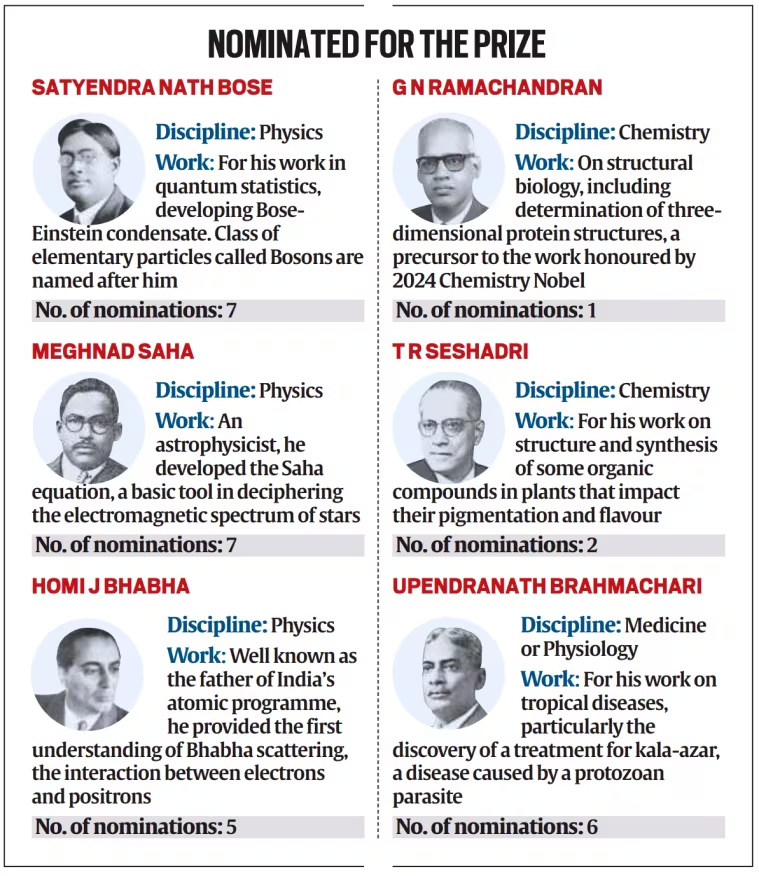



Copyright infringement not intended
Picture Courtesy: INDIANEXPRESS
India has not produced a Nobel laureate in science for research conducted within the country since Sir C.V. Raman in 1930, this highlights systemic challenges in the research ecosystem, as several Indian-origin scientists win the prize for work done abroad.
India's investment and output in high-quality research lag behind global benchmarks.
While India ranked 39th in the Global Innovation Index 2024 and has seen a surge in patent filings, fundamental challenges remain.
|
Metric |
India |
Global Leaders |
|
Gross Expenditure on R&D (GERD) as % of GDP |
0.6%-0.7% |
Israel (5.6%), South Korea (4.9%), USA (3.5%), China (2.4%) |
|
Private Sector Contribution to GERD |
36% |
Over 70% in most developed nations |
|
Researchers per Million People |
255 |
South Korea (7,980), USA (4,452), China (1307) |
Underfunding in R&D
India's R&D is underfunded at only 0.64% of GDP, hindering access to advanced equipment and preventing the long-term, high-risk projects needed for discoveries.
Systemic & Infrastructural Flaws
Researchers face bureaucratic funding delays and poor infrastructure such as outdated equipment and limited database access.
Government funding priorities applied, commercially-focused "translational research" at the expense of fundamental, curiosity-driven science, which is the source of major scientific discoveries.
Lack of Research Culture
A focus on publication volume over impact, combined with limited institutional freedom, creates a research culture that discourages the unconventional, high-impact work recognized by Nobel Prizes and raises integrity concerns.
Brain Drain
The migration of leading scientific minds to other nations, driven by the lure of better research facilities, higher compensation, and superior infrastructure, negatively impacts the domestic research ecosystem.
|
Name |
Year |
Field |
Contribution |
Notes |
|
Har Gobind Khorana |
1968 |
Physiology or Medicine |
Genetic code and protein synthesis |
Born in India, worked in US |
|
Subrahmanyan Chandrasekhar |
1983 |
Physics |
Structure and evolution of stars |
Born in India, worked in US |
|
Venkatraman Ramakrishnan |
2009 |
Chemistry |
Structure and function of the ribosome |
Born in India, worked in UK/US |
 Weak Academia-Industry Linkages
Weak Academia-Industry Linkages
Lack of collaboration between academia and industry hinders the practical application of research, limiting the translation of lab discoveries and decreasing industry research funding; increases reliance on public resources.
Anusandhan National Research Foundation (ANRF)
Established by the ANRF Act 2023, to mobilize ₹50,000 crore over 5 years (2023-28) from public and private sources to seed, grow, and promote R&D, especially in universities, and strengthen industry-academia linkages.
Research Development and Innovation (RDI) Scheme Fund
A ₹1 lakh-crore corpus to offer long-term, low or zero-interest loans to mitigate innovation risk and spur private R&D investment in emerging "sunrise" sectors.
National Quantum Mission (NQM)
Launched in 2023 with a budget of over ₹6,000 crore (2023-2031) to establish India as a global leader in Quantum Technology R&D.
Talent Retention Schemes
Programs like INSPIRE, Ramanujan, and VAIBHAV Summit aim to attract and retain high-quality scientific talent, including Indian diaspora researchers.
Boost R&D Investment: Increase GERD to at least 2% of GDP, as suggested by the Science, Technology and Innovation (STI) Policy 2013.
Encourage a Culture of Inquiry: The research-oriented vision of the National Education Policy (NEP) 2020 should be implemented to encourage thinking and creativity from the school level.
Modernize Research Infrastructure: Create and upgrade a network of world-class, shared research facilities accessible to scientists across the country.
Ensure "Ease of Doing Research": Streamline funding processes, remove bureaucratic red tape, and grant greater autonomy to scientific institutions and researchers.
Incentivize "Brain Gain": Create a compelling ecosystem with globally competitive salaries, better working conditions, and clear career progression paths to attract Indian talent back home.
To become a global knowledge superpower and secure Nobel Prizes, India needs sustained political commitment, increased funding for fundamental science, and a culture prioritizing curiosity and high-risk research.
Source: INDIAN EXPRESS
|
PRACTICE QUESTION Q. Critically analyze the structural and systemic factors within India's scientific ecosystem that hinder the production of Nobel laureates. 150 words |
The reason is the absence of a robust, world-class research ecosystem, stemming from factors like insufficient funding, inadequate infrastructure, excessive bureaucracy, and a prevailing academic culture that prioritizes quantity of publications over high-impact, groundbreaking research.
India's public R&D spending is low at about 0.64% of GDP, less than countries with many Nobel laureates like the USA (3.5%) and Israel (5.7%). This insufficient funding limits sustained, foundational research.
India must boost R&D funding, simplify bureaucracy, ensure transparent, merit-based academic hiring, and support high-risk fundamental research. Enhanced global partnerships and increased private sector R&D investment are also vital.
© 2025 iasgyan. All right reserved